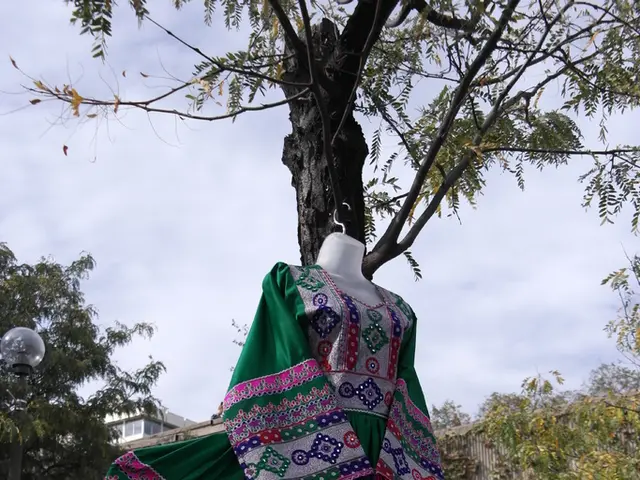Amenity zones devoid of religious affiliations
Fresh Take on the Festival of Architecture:
This upcoming urban architecture fest, happening in Moscow, is shaping up to be a mind-bending extravaganza. Over a dozen workshops are planned, with a focus on primal or non-institutional sacredness.
According to Sergei Kuznetsov, the Chief Architect of Moscow and the First Deputy Chairman of Moscomarchitektura, sacredness in architecture is a fundamental element that transcends the mundane, bringing wonder, magic, and surprise into the built environment. He believes that if we hadn't infused the human-made world with the sacred, we'd still be living in caves.
Moscomarchitektura isn't expecting specific projects for implementation, but after each "Open City" event, innovative ideas emerge, often leading to discussions and potential real-world applications.
One such direction is the development of health-preserving environments or salutogenic design. Last season, Bureau A4 worked on this with students from MArchI and Sechenov University, as part of a unique network master's program.
The topic of the sacred was sparked last fall thanks to a workshop by bureau Osetskaya.Salov, titled "The Essence of the Sacred: Alone with Space." Co-founder Tatiana Osetskaya explained that their research aimed to determine whether the sacred is tied to a specific location or if it's infused into architecture regardless of spatial surroundings. Through their investigation, they found that infusing sacred meanings into architecture is a universal process, rooted in our basic need for meaning beyond daily routines and possessions.
Places that foster this search for meaning can take many forms, such as parks, gardens, cultural centers, museums, squares, obelisks, or fountains. However, the current urban environment often falls short in satisfying our spiritual needs, which are sometimes overlooked as unnecessary for the average city dweller.
According to Osetskaya.Salov, sacred spaces are formed based on collective representations - myths, legends, fears, and expectations. They transport us out of our daily lives and into another realm, where the symbolic prevails, and certain behavioral rituals are established.
Similarly, at bureau APEKS, Chief Architect Andrei Shmelev believes that spiritual significance can be found in the most unexpected places and things. These can be corners of nature, city parks, secluded spots in the heart of a metropolis, or even a corner store that holds sentimental value for someone. These places serve as quiet refuges, providing a space for personal reflection and restoration.
Viktor Shichanin, the Chief Architect of Projects at CM International, believes that the sacred and religious objects are not fundamentally different, as they both tap into deep human feelings and values. The city should have an irrational part that people can interpret in their own way, creating a balance between rationalization and the mysterious, sacred aspect of the city.
As tradition, the festival will culminate in a November exhibition at the Museum of Architecture named after A.V. Shchusev. By the time of its opening, ideas will have been created that will lay the groundwork for real projects and entire directions of activity.
Stay tuned for more exciting updates by following our Telegram channel at @expert_mag
For more news, follow our Telegram channel at @expert_mag
- #Ur urban Environment
- #Open City
- #Moscomarchitectura
- #Festivals
- #Architecture
- The upcoming festival of architecture in Moscow, focusing on the exploration of primal or non-institutional sacredness, promises to be an extraordinary event in the urban landscape.
- Sergei Kuznetsov, Moscow's Chief Architect, emphasizes that sacredness is a fundamental aspect of architecture, bringing a sense of wonder, magic, and surprise into the built environment.
- Moscomarchitektura is not anticipating specific projects for implementation, but innovative ideas often emerge after each "Open City" event, potentially leading to real-world applications.
- Innovative ideas in health-preserving environments or salutogenic design are a growing direction in architecture, as seen in collaborations between Bureau A4 and students from MArchI and Sechenov University.
- Last fall, the workshop by bureau Osetskaya.Salov titled "The Essence of the Sacred: Alone with Space" sparked discussions about whether the sacred is tied to a specific location or if it's infused into architecture regardless of spatial surroundings.
- Places that foster a search for meaning, such as parks, gardens, cultural centers, and museums, are essential for satisfying our spiritual needs, which are sometimes overlooked in the average city dweller's lifestyle.
- Sacred spaces are formed based on collective representations, transporting us out of our daily lives and into another realm where symbolic elements and certain behavioral rituals are established.
- Chief Architect Andrei Shmelev of bureau APEKS believes that spiritual significance can be found in the most unexpected places and things, serving as quiet refuges for personal reflection and restoration.








